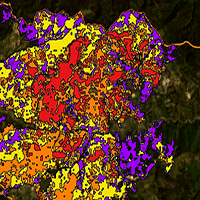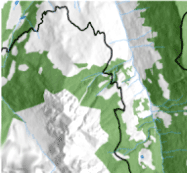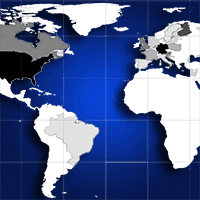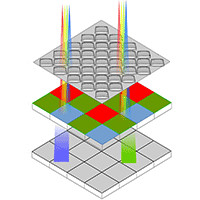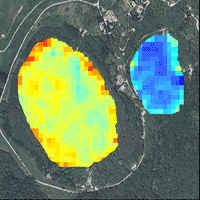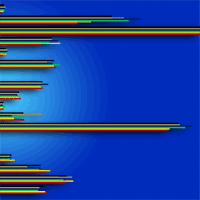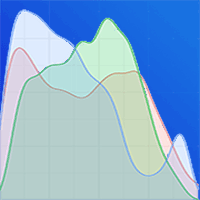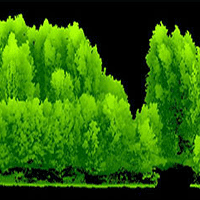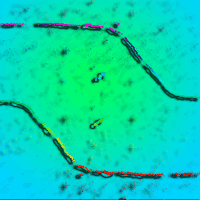This study aimed to assess the hydrological and erosive effects of different levels of the fire severity in the drainage basin of the Trionto River (Calabria, southern Italy), which was partially burned by intense fires during the summer 2017. The analysis focused on the identification of wildfire areas using a supervised classification of remote sensing images with the minimum distance algorithm. The level of severity of each fire was then discriminated based on a procedure proposed by the U.S. Department of Agriculture and adapted to the study area. To evaluate how wildfire occurrence affects the hydrological behaviour at the basin scale, the SCS-Curve Number model was used to document pre- and post-fire conditions in relation with the level of fire severity. Finally, the influence on erosion was analysed for analogous conditions at the basin scale using the RUSLE equation. The effects on hydrological balance and soil loss were evaluated by comparing the pre-fire value with three different post-fire scenarios: (a) different levels of severity on the surface covered by the fire (real case); (b) maximum level of severity on the surface covered by the fire; (c) total loss of the canopy and formation of a hydrophobic layer on the surface soil. The results confirmed that the level of severity of the forest fires, combined with climatic factors, morphological conditions, and the pedological characteristics of the basin, significantly influence changes to the hydrology and rates of erosion. Moreover, these impacts proved to be mainly dependent on the consequent, often notable, heterogeneity in the spatial distribution of burned areas with different severity.
Keywords
, , ,
Citation
Coschignano G, Nicolaci A, Ferrari E, Cruscomagno F, Iovino F (2019). Evaluation of hydrological and erosive effects at the basin scale in relation to the severity of forest fires. iForest 12: 427-434. - doi: 10.3832/ifor2878-012
Academic Editor
Angelo Nolè
Paper history
Received: Jun 02, 2018
Accepted: Jun 12, 2019
First online: Sep 01, 2019
Publication Date: Oct 31, 2019
Publication Time: 2.70 months
© SISEF - The Italian Society of Silviculture and Forest Ecology 2019
Open Access
This article is distributed under the terms of the Creative Commons Attribution-Non Commercial 4.0 International (https://creativecommons.org/licenses/by-nc/4.0/), which permits unrestricted use, distribution, and reproduction in any medium, provided you give appropriate credit to the original author(s) and the source, provide a link to the Creative Commons license, and indicate if changes were made.

Breakdown by View Type
(Waiting for server response...)
Article Usage
Total Article Views: 43519
(from publication date up to now)
Breakdown by View Type
HTML Page Views: 36668
Abstract Page Views: 3245
PDF Downloads: 2835
Citation/Reference Downloads: 5
XML Downloads: 766
Web Metrics
Days since publication: 2281
Overall contacts: 43519
Avg. contacts per week: 133.55
Article Citations
Article citations are based on data periodically collected from the Clarivate Web of Science web site
(last update: Mar 2025)
Total number of cites (since 2019): 5
Average cites per year: 0.71
Publication Metrics
by Dimensions ©
Articles citing this article
List of the papers citing this article based on CrossRef Cited-by.
(1)
Bosco C, De Rigo D, Dewitte O, Poesen J, Panagos P (2015)Modelling soil erosion at European scale: towards harmonization and reproducibility. Natural Hazards and Earth System Sciences 15: 225-245.
CrossRef |
Gscholar
(2)
Candela A, Aronica G, Santoro M (2005)Effects of forest fires on flood frequency curves in a Mediterranean catchment. Hydrological Sciences Journal 50 (2): 193-206.
CrossRef |
Gscholar
(3)
Canfield HE, Goodrich DC, Burns IS (2005)Application of models to predict post-fire runoff and sediment transport at the watershed scale in southwestern forests. In: Proceedings of the “2005 Watershed Management Conference - Managing Watersheds for Human and Natural Impacts: Engineering, Ecological, and Economic Challenges” (Moglen GE ed). American Society of Civil Engineers, Reston, VA, USA, pp. 1-12.
Gscholar
(4)
Chafer CJ (2008)A comparison of fire severity measures: an Australian example and implications for predicting major areas of soil erosion. Catena 74 (3): 235-245.
CrossRef |
Gscholar
(5)
Chafer CJ, Noonan M, Macnaught E (2008)The post-fire measurement of fire severity and intensity in the Christmas 2001 Sydney wildfires. International Journal of Wildland Fire 13: 227-240.
CrossRef |
Gscholar
(6)
Chirici G, Corona P (2006)Utilizzo di immagini satellitari ad alta risoluzione nel rilevamento delle risorse forestali [Use of high-resolution satellite images for forest resources surveying]. Aracne Editrice, Rome, Italy, pp. 192. [in Italian]
Gscholar
(7)
Cocke AE, Fulè PZ, Crouse JE (2005)Comparison of burn severity assessments using differenced normalized burn ratio and ground data. International Journal of Wildland Fire 14: 189-198.
CrossRef |
Gscholar
(8)
Congalton RG, Green K (2009)Assessing the accuracy of remotely sensed data: principles and practices (2nd edn). CRC Press, Taylor and Francis Group, Boca Raton, FL, USA, pp. 183.
Gscholar
(9)
DeBano LF (1981)Water repellent soils: a state of the art. General Technical Report PSW-46, USDA Forest Service, Pacific Southwest Forest and Range Experiment Station, Berkeley, CA, USA, pp. 25.
Online |
Gscholar
(10)
DeBano LF, Neary DG, Ffolliott PF (1998)Fire’s effects on ecosystems. John Wiley and Sons, New York, USA, pp. 159-196.
Gscholar
(11)
DeBano LF (2000)The role of fire and soil heating on water repellency in wildland environments: a review. Journal of Hydrology 231-232: 195-206.
CrossRef |
Gscholar
(12)
Desmet PJJ, Govers G (1996)A GIS procedure for automatically calculating the USLE LS factor on topographically complex landscape units. Journal of Soil and Water Conservation 51: 427-433.
Online |
Gscholar
(13)
Dimase AC, Iovino F (1996)I suoli dei bacini idrografici del Trionto, Nicà e torrenti limitrofi (Calabria). [The soils of the Trionto and Nicà drainage basins and conterminous rivers (Calabria, Italy)]. Accademia Italiana di Scienze Forestali, Nuova Stamperia, Firenze, Italy, pp. 112. [in Italian]
Gscholar
(14)
Ebel BA, Moody JA, Martin DA (2012)Hydrologic conditions controlling runoff generation immediately after wildfire. Water Resources Research 48 (3): 329.
CrossRef |
Gscholar
(15)
Epting J, Verbyla D, Sorbel B (2005)Evaluation of remotely sensed indices for assessing burn severity in interior Alaska using Landsat TM and ETM+. Remote Sensing of Environment 96 (3-4): 328-339.
CrossRef |
Gscholar
(16)
Escuin S, Navarro R, Fernández P (2008)Fire severity assessment by using NBR (Normalized Burn Ratio) and NDVI (Normalized Difference Vegetation Index) derived from LANDSAT TM/ ETM images. International Journal of Remote Sensing 29 (4): 1053-1073.
CrossRef |
Gscholar
(17)
Griffin M, Beasley D, Fletcher J, Foster G (1988)Estimating soil loss on topographically nonuniform field and farm units. Journal of Soil and Water Conservation 43: 326-331.
Online |
Gscholar
(18)
Hessling M (1999)Hydrological modelling and pair basin study of Mediterranean catchments. Physics and Chemistry of the Earth, Part B: Hydrology, Oceans and Atmosphere 24 (1-2): 59-63.
CrossRef |
Gscholar
(19)
Higginson B, Jarnecke J (2007)Salt Creek BAER-2007 burned area emergency response. Hydrology Specialist Report, Uinta National Forest, Provo, UT, USA, pp. 11.
Gscholar
(20)
Hudak AT, Morgan P, Bobbitt MJ, Smith AMS, Lewis SA, Lentile LB, Robichaud PR, Clark JT, McKinley RA (2007)The relationship of multispectral satellite imagery to immediate fire effects. Journal of Fire Ecology 3: 64-90.
Online |
Gscholar
(21)
Inbar M, Tamir M, Wittenberg L (1998)Runoff and erosion processes after a forest fire in Mount Carmel, a Mediterranean area. Geomorphology 24: 17-33.
CrossRef |
Gscholar
(22)
Key C, Benson N (2005)Landscape assessment: ground measure of severity; the Composite Burn Index, and remote sensing of severity, the Normalized Burn Index. In: “FIREMON: Fire Effects Monitoring and Inventory System”. General Technical Report RMRS-GTR-164-CD, USDA Forest Service, Rocky Mountain Research Station, Fort Collins, CO, USA, pp. 1-51.
Gscholar
(23)
Kirkby MJ, Morgan RPC (1980)Soil erosion. John Wiley and Sons, Chichester, UK, pp. 316.
Gscholar
(24)
Landis JR, Koch G (1977)The measurement of observer agreement for categorical data. Biometrics 33 (1): 159-174.
CrossRef |
Gscholar
(25)
Lentile LB, Holden ZA, Smith AMS, Falkowski MJ, Hudak AT, Morgan P, Lewis SA, Gessler PE, Benson NC (2006)Remote sensing techniques to assess active fire characteristics and post-fire effects. International Journal of Wildland Fire 15: 319-345.
CrossRef |
Gscholar
(26)
Leopardi M, Scorzini AR (2015)Effects of wildfires on peak discharges in watersheds. iForest - Biogeosciences and Forestry 8 (3): 302-307.
CrossRef |
Gscholar
(27)
Lutes DC, Keane RE, Caratti JF, Key CH, Benson NC, Sutherland S, Gangi LJ (2006)FIREMON: fire effects monitoring and inventory system. General Techical Report RMRS-GTR-164-CD, NRRC, USDA Forest Service, Rocky Mountain Research Station, Fort Collins, CO, USA, pp. 400.
CrossRef |
Gscholar
(28)
Malkinson D, Wittenberg L (2011)Post fire induced soil water repellency - modeling short and long-term processes. Geomorphology 125: 186-192.
CrossRef |
Gscholar
(29)
McLin SG, Springer EP, Lane LJ (2001)Predicting floodplain boundary changes following the Cerro Grande wildfire. Hydrological Processes 15 (15): 2967-2980.
CrossRef |
Gscholar
(30)
Mitasova H, Hofierka J, Zlocha M, Iverson LR (1996)Modeling topographic potential for erosion and deposition using GIS. International Journal of Geographical Information Science 10 (5): 629-641.
Gscholar
(31)
Moody JA, Martin DA (2001)Post-fire, rainfall intensity-peak discharge relations for three mountainous watersheds in the western USA. Hydrological Processes 15: 2981-2993.
CrossRef |
Gscholar
(32)
Moody JA, Shakesby RA, Robichaud PR, Cannon SH, Martin DA (2013)Current research issues related to post-wildfire runoff and erosion processes. Earth-Science Reviews 122: 10-37.
CrossRef |
Gscholar
(33)
Moore ID, Burch GJ (1986)Physical basis of the length-slope factor in the universal soil loss equation. Soil Science Society of America 50 (5): 1294-1298.
CrossRef |
Gscholar
(34)
Moore ID, Wilson J (1992)Length-slope factors for the revised universal soil loss equation: simplified method of estimation. Journal of Soil and Water Conservation 47: 423-428.
Online |
Gscholar
(35)
Morgan P, Hardy CC, Swetnam TW, Rollins MG, Long DG (2001)Mapping fire regimes across time and space: understanding coarse and fine-scale fire patterns. International Journal of Wildland Fire 10: 329-342.
Online |
Gscholar
(36)
Morris SE, Moses TA (1987)Forest fire and the natural soil erosion regime in the Colorado Front Range. Annals of the Association of American Geographers 77: 245-254.
CrossRef |
Gscholar
(37)
Nespola N (2017)Roghi nella Ue: serve una cultura della prevenzione. Quali interventi si stanno adottando? Il problema è sia l’emergenza in atto, sia la prospettiva di lungo termine [Forest fires in the EU: a culture of prevention is needed. What interventions are they taking? The problem is both the ongoing emergency and the long-term perspective]. Web site. [in Italian]
Online |
Gscholar
(38)
Onda Y, Dietrich WE, Booker F (2008)Evolution of overland flow after a severe forest fire. Point Reyes, California. Catena 72: 13-20.
CrossRef |
Gscholar
(39)
Panagos P, Borrelli P, Meusburger K (2015)A new european slope length and steepness factor (LS-Factor) for modeling soil erosion by water. Geosciences 5: 117-126.
CrossRef |
Gscholar
(40)
Papathanasiou C, Makropoulos C, Mimikou M (2015)Hydrological modelling for flood forecasting: calibrating the post-fire initial conditions. Journal of Hydrology 529: 1838-1850.
CrossRef |
Gscholar
(41)
Parson A, Robichaud PR, Lewis SA, Napper C, Clark JT (2010)Field guide for mapping post-fire soil burn severity. General Techical Report RMRS-GTR-243, USDA Forest Service, Rocky Mountain Research Station, Fort Collins, CO, USA, pp. 49.
CrossRef |
Gscholar
(42)
Robichaud PR (2000)Fire effects on infiltration rates after prescribed fire in northern Rocky Mountain forests, USA. Journal of Hydrology 231-232: 220-229.
CrossRef |
Gscholar
(43)
Robichaud PR, Lewis SA, Ashmun LE (2008)New procedure for sampling infiltration to assess post-fire soil water repellency. Research Note RMRS-RN-3, USDA Forest Service, Rocky Mountain Research Station, Fort Collins, CO, USA, pp. 14.
CrossRef |
Gscholar
(44)
Rogan J, Franklin J (2002)Mapping wildfire burn severity in southern California forests and shrublands using enhanced thematic mapper imagery. Geocarto 16: 89-99.
Gscholar
(45)
Rulli MC, Rosso R (2005)Modeling catchment erosion after wildfires in the San Gabriel Mountains of southern California. Geophysical Research Letters 32: L19401.
CrossRef |
Gscholar
(46)
San-Miguel-Ayanz J, Durrant T, Boca R, Libertà G, Branco A, De Rigo D, Ferrari D, Maianti P, Artés Vivancos T, Schulte E, Loffler P (2017)Forest Fires in Europe, Middle East and North Africa 2016. EUR 28707 EN, EU Publications Office, Luxembourg, pp. 126.
Gscholar
(47)
Shakesby RA, Doerr SH (2006)Wildfire as a hydrological and geomorphological agent. Earth-Science Reviews 74: 269-307.
CrossRef |
Gscholar
(48)
Shakesby RA (2011)Post-wildfire soil erosion in the Mediterranean: review and future research directions. Earth-Science Reviews 105 (3-4): 71-100.
CrossRef |
Gscholar
(49)
Soto B, Diaz-Fierros F (1998)Runoff and soil erosion from areas of burnt scrub: comparison of experimental results with those predicted by the WEPP model. Catena 31: 257-70.
CrossRef |
Gscholar
(50)
Soulis KX (2018)Estimation of SCS curve number variation following forest fires. Hydrological Sciences Journal 63 (9): 1332-1346.
CrossRef |
Gscholar
(51)
Stoof CR, Vervoort RW, Iwema J, Van Den Elsen E, Ferreira AJD, Ritsema CJ (2012)Hydrological response of a small catchment burned by experimental fire. Hydrology and Earth System Sciences 16: 267-285.
CrossRef |
Gscholar
(52)
Terranova O, Antronico L, Coscarelli R, Iaquinta P (2009)Soil erosion risk scenarios in the Mediterranean environment using RUSLE and GIS: an application model for Calabria (southern Italy). Geomorphology 112: 228-245.
CrossRef |
Gscholar
(53)
Turco M, Von Hardenberg J, AghaKouchak A, Llasat MC, Provenzale A, Trigo RM (2017)On the key role of droughts in the dynamics of summer fires in Mediterranean Europe. Scientific Reports 7 (1): 11.
CrossRef |
Gscholar
(54)
USDA (1986)Urban hydrology for small watersheds. Technical Release 55, USDA, Washington, DC, USA, pp. 164.
Gscholar
(55)
Wischmeier WH, Smith DD (1978)Predicting rainfall erosion losses: a guide to conservation planning. Agriculture Handbook no. 537, USDA, Washington DC, USA, pp. 13-27.
Online |
Gscholar
